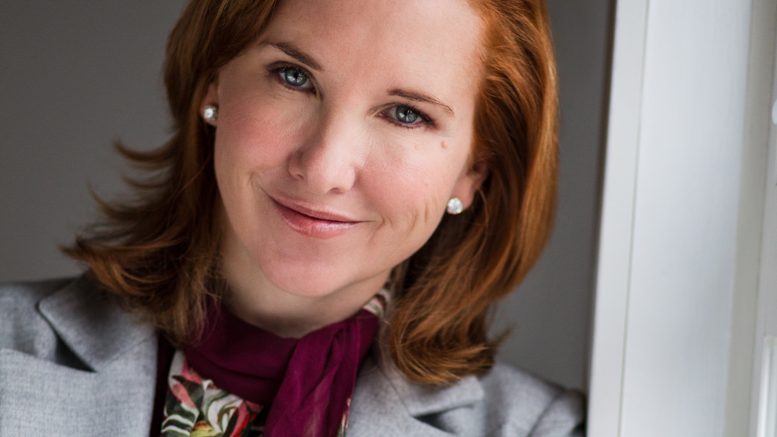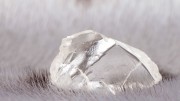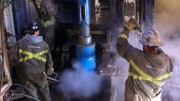Lightning has struck more than once so far in Eira Thomas’s career of more than 25 years.
The geologist famously spotted a nearly 2-carat diamond in drill core — an incredibly rare occurrence — during exploration at Lac de Gras in 1994, at what would become the Diavik mine in the Northwest Territories.
And as a founder and director of Lucara Diamond (TSX: LUC), she was part of the leadership when the company unearthed a 1,109-carat stone — the second largest diamond in history — at its Karowe mine in Botswana in November 2015.
“I’ve been very fortunate,” said Thomas in an interview in May. “Those were obviously two exciting milestones for me in my career, but I think with each and every project that I’ve worked on there’ve been those moments.”
While those moments have not always been so dramatic, they have been extremely satisfying and meaningful, she adds.
“A lot of it has to do with being involved in a good project with good people,” says Thomas, whose father Grenville Thomas is one of the pioneers of Canadian diamonds as a founder of Aber Diamond.
Other “good projects” that Thomas has been involved with: As a cofounder and CEO of Stornoway Diamond (TSX: SWY), she led the junior through the first phases of acquiring Renard in 2007 — now Quebec’s first diamond mine — and then through an extremely successful advanced exploration program. And as CEO of Yukon junior Kaminak Gold, she spent three years advancing the Coffee gold deposit before negotiating the company’s $520-million acquisition by Goldcorp (TSX: GG) in 2016.
Now Thomas is taking on a new full-time role at Lucara — and bringing her own stamp to the company.
Digital platform
Last year, the Lucara board approached Thomas about joining the company as CEO to replace William Lamb, who was stepping down.
While it was clearly a natural fit for Thomas, who had cofounded the company with Lukas Lundin and Catherine McLeod-Seltzer in 2007, there was one thing in the way. She was deeply involved in Clara Diamond Solutions, a fledging technology company that was working to bring its proprietary secure digital sales platform for diamonds to market.
“When I was approached by the board, I had already been moving down a path towards an IPO establishing a new public company for Clara,” she says.
“I told them: ‘Look, I’m not in a position to abandon Clara, so we need to figure out whether or not there’s any synergy here and whether this could make sense to combine the two.”
She had previously approached Lundin, Lucara’s chairman, about finding a place for Clara within Lucara, but the solution wasn’t far enough along to make sense for Lucara at the time.
This time, outgoing CEO William Lamb spearheaded the due diligence work. “He invested a great deal of time looking at it and he came back to the Clara board with a recommendation that they acquire it.”
In February, Lucara named Thomas as CEO, and at the same time, announced the acquisition of Clara for an initial 13.1 million Lucara shares, worth around $29 million. Another 13.4 million shares will follow in staged payments as certain milestones related to revenue generated by Clara are achieved.
Like De Beers’ recent announcement about a blockchain initiative that will track diamonds from source to retail, Clara uses secure blockchain technology that will assure customers of the provenance of all diamonds sold through it. But Thomas says that’s just a side benefit of the technology.
“Clara fundamentally is a business solution,” Thomas says. “It transforms how diamonds are actually sold, so it’s quite a different concept.”
The platform uses computing algorithms to match rough diamond production to buyers who want stones with the same characteristics. Management believes that the technology can improve margins for both buyers and sellers, and testing has indicated the potential to unlock more than 20% of value throughout the diamond pipeline to the benefit of all parties, the company says.
For Lucara, the potential of Clara is twofold — both to increase the prices it receives for Karowe production, and to generate revenue independently of Karowe. Clara’s revenue model is based on capturing a portion of the incremental value that the technology unlocks.
“Clara’s exciting because for the first time in the history of the company, it provides us with an avenue for growth outside of Karowe,” Thomas says. “And though it’s not a mining opportunity, it’s a diamond opportunity that’s very compatible with our core diamond mining business.”
The company will soon be able to prove the benefits of its new acquisition. Lucara plans to start selling Karowe’s production through Clara in the third quarter. After that, the company will allow other diamond producers to try the platform.
“We’re offering an opportunity to sell a portion of their diamonds through Clara and they can compare against their existing sales processes to determine if there’s a benefit,” Thomas explains. “We think of course we’ll be able to demonstrate that there is. We believe that they will realize higher diamond prices for their rough. They will also be selling diamonds in real time, no longer tethered to a five-week sales process.”
While a departure for any diamond company, adoption of the digital technology is in some ways in keeping with Lucara’s reputation. The company has used innovative technology in its processing plant to improve recoveries and reduce breakage.
An exceptional asset
As Lucara’s CEO, Thomas is for the first time in her career, responsible for an operating asset.
While her experience has been heavy in exploration, including two years as vice-president exploration at Aber Diamond in the late 1990s, Thomas says her experience with projects ranging from exploration to feasibility to operations, including her 14 years as a director on the board of major oilsands player Suncor Energy (TSX: SU), means she’s well prepared for the job.
“I think so much of what we do as senior leaders really relies and depends on the team that you’re able to build to support your strategy. At Lucara, I’m lucky to be inheriting a very strong core leadership team that I can add to.”
Thomas has already made some changes to senior leadership in Botswana, including the promotion to managing director of former in-country CFO Naseem Lahri, the first Motswana woman to become managing director of a diamond company.
Karowe, which began production in 2012 and has delivered many exceptional large, Type II a stones (including the 1,109-carat Lesedi La Rona and the 813-carat Constellation diamond, which sold for US$63.1 million), is an exceptional asset. So much so that it’s supported a regular dividend since 2014.
But a great asset on its own isn’t enough.
“It’s important when you’re looking at leadership, especially with leadership renewal, that you don’t lose sight of the fact that with high-margin assets like Karowe, it’s easy to become complacent because you almost can’t help but make money,” Thomas said.
“We have an opportunity to refocus our efforts and look hard at where we can drive operational efficiencies and improve overall performance to impact the bottom line.”
The open-pit operation, which is expected to produce 270,000 to 290,000 carats of diamonds this year, has enough ore to support mining to 2026, but Lucara is looking at the potential for underground mining at the AK6 kimberlite. Following a positive preliminary economic assessment released in November 2017, the company expects to complete a prefeasibility study on underground development before the end of the year. The PEA showed the potential for a 10-year mine life extension and another 2.72 million carats of production with a preproduction capital cost of US$195 million.
Future plans
Since acquiring a majority stake in Karowe (then known as AK6) in 2009 and then consolidating ownership in 2010, the project has been Lucara’s main focus.
But with the company soon to name an executive in charge of corporate development, Thomas says it will be looking at M&A opportunities.
“We’ve got an economic engine at Karowe that will continue to support and sustain our current business plan and the dividend and I think that affords us an opportunity now to look a little bit beyond.”
Canada and Botswana are at the top of the list in terms of low-risk jurisdictions with diamond potential, but Thomas says Lucara will keep an open mind.
“The diamond universe is pretty small — there’s very few players and very few producing diamond mines. And it’s a difficult commodity to explore for, it’s expensive and it’s high risk,” she says. “So I think as a leading mid-tier diamond producer, we will necessarily have to look broadly and not restrict ourselves too much. But certainly, we’ll start with the safer jurisdictions like Botswana and Canada.”
As for the diamond market itself, Thomas says that it is recovering nicely from 2017, and that some stability — along with margins in the downstream — has started to return after a volatile period. Longer-term, the supply and demand fundamentals look very good.
“We just haven’t made any new, world-class discoveries that can replace the declines we’re seeing from all major diamond producers,” she says, adding that Rio Tinto’s (NYSE: RIO) closure of the Argyle mine in Australia will take a significant amount of production off the market.
While diamond exploration no longer has the sheen of excitement around it that it did during the 1990s, Thomas is a strong believer that that excitement could return.
“It’s going to take an important discovery, something new and exciting, but I think it’s absolutely possible,” she says, adding that there’s a good chance it could happen in relatively underexplored Canada a second time.
Lessons learned
Having worked with Grenville Thomas at Aber and now being involved with his current venture North Arrow Minerals (TSXV: NAR) as an advisor, her father has undoubtedly been an important mentor for Thomas.
“He’s just so driven when it comes to exploration — his enthusiasm has never waned,” Thomas says, noting that he still calls her up when he wants to show her drill core he’s excited about.
But the most enduring lessons Thomas learned from her dad were around leadership, she says.
“My dad was a mining engineer that had a passion for exploration but he wasn’t a geologist. What he did is he surrounded himself with a lot of smart people that had the expertise that he didn’t and I would argue that he’s become probably as much of an expert in geology as I am as a trained geologist.”
That respect for expertise extended to hiring local First Nations people as part of exploration teams in the bush — long before it became part of many companies’ mandates.
“He wanted to work with people that know and understand how to explore in remote places like northern Canada, so of course you’d hire local First Nations because those are the guys that had the most experience.”
It’s clear that her father’s strength in building a team and showing respect has resonated with Thomas.
“I think that’s been a big lesson for me, watching him put together the right mix of skills and experience with people that can work within our northern communities of interest and actually be successful,” she says.
“It’s never a one-man band, it’s always about the team.”
— This article originally appeared in the June 2018 issue of Diamonds in Canada magazine.




Be the first to comment on "Eira Thomas takes the reins at Lucara"